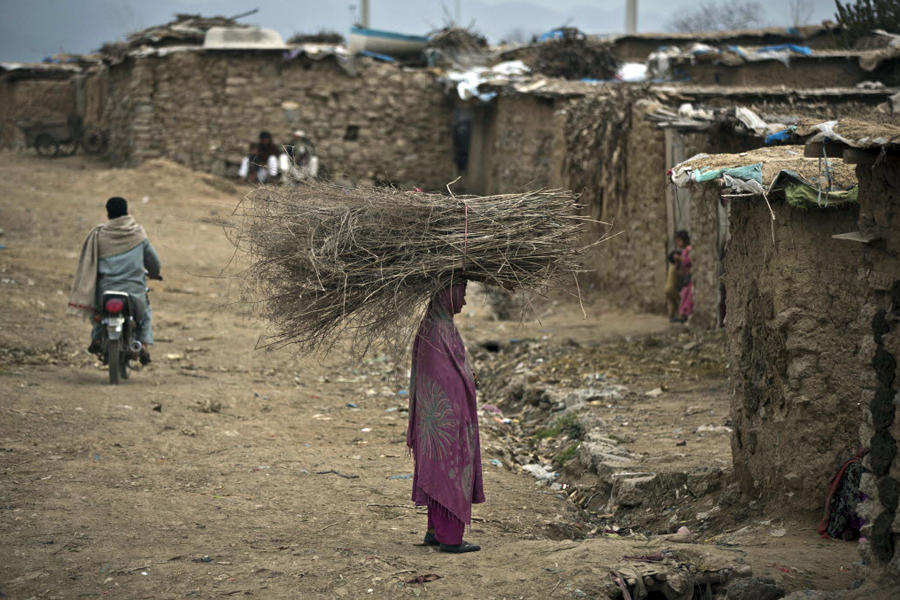Pakistan holds peace talks with Taliban: 5 things you need to know
Loading...
| Islamabad
Pakistan government officials held their first direct talks with the leadership of the Pakistan Taliban (known as Tehrik e Taliban Pakistan or TTP) today, meeting at an undisclosed location in the country's northwest.
Talks earlier this year were held between intermediaries for the two groups, but today was a rare direct communication between the two sides. No direct contact had been made since Prime Minister Nawaz Sharif was elected last June.
Tens of thousands of civilians have been killed by the TTP since 2007, in attacks on military installations, mosques, and market places across the country. The group has also claimed responsibility for killing seven CIA agents in Afghanistan in 2009, and an attempted car bombing in New York City's Times Square in 2010.
Here's a rundown of who is involved, and what's at stake:
How significant is it that the Pakistani government is talking directly with the TTP?
It's the first time Pakistan's civilian leadership has sat down with the leaders of the TTP, the largest and most influential militant outfit in the country. No previous attempts at peace talks – by the military or civilian leadership – have had the kind of mandate as these do.
The Pakistani military has inked four major peace agreements with militants since 2003, but only one survives today. A 2008 agreement between the civilian government and Sufi Muhammad, an aging cleric and the father-in-law of the TTP's current head, Maulvi Fazlullah, fell apart over a disagreement on how to impose Sharia law in the Swat valley.
In last May's elections, Pakistan's two leading political parties campaigned on a platform of peace talks. Afterwards, all major parties threw their weight behind negotiations, which Prime Minister Nawaz Sharif has called the “last chance” for the TTP.
Why is it so difficult to negotiate with the TTP?
The TTP began as a coalition of scores of militant groups, and the numbers have grown since then. In Pakistan's largest city, Karachi, security officials count at least four separate operating TTP outfits.
The talks have highlighted existing splits within those organizations, giving rise to splinter groups like Ahrar-ul-Hind, which have refused to adhere to a TPP ceasefire. On March 2, its fighters killed 11 people at a judicial complex in Islamabad. Two weeks later, it orchestrated simultaneous bombings in Quetta and Peshawar, killing 19, including women and children.
According to Ibrahim Khan, a politician who helped to organize the face-to-face meeting, the militants today offered to help the government to locate and neutralize Ahrar-ul-Hind.
The overtures aside, if the TTP cannot control splinter groups like Ahrar-ul-Hind, public support for any kind of talks could evaporate.
What is the TTP looking for in the talks?
The group's stated goal is to replace the Pakistani government with one that runs according to its interpretation of Islamic law. That goal is unlikely to become reality: Pakistan's constitution already states that no law will be made that contradicts Islamic principles.
There are signs that the TTP might also be willing to forgo another unrealistic demand: toppling the entire government. Maulana Abdul Aziz, the head of the radical Red Mosque in Islamabad, was an original member of a group of mediators nominated by the TTP, but was quickly sidelined when he insisted on throwing out the constitution altogether as a key condition for the talks.
More practically, the TTP demands the release of hundreds of its members held by the government, and the cutback on the military's presence in Waziristan, perhaps even a full withdrawal.
What impact could a peace deal have on Afghanistan?
The TTP is one of dozens of groups that operate across the border, and its leader, Maulvi Fazlullah, is hiding in Afghanistan.
A military effort to clear militants from either side of the border – by Afghan and NATO forces, or by Pakistan – will require extensive cooperation from both countries. That will be difficult after NATO withdraws from Afghanistan, some time next year. If a settlement with the TTP results in a sanctuary for militants in Pakistan, it could hand the Afghan Taliban a safe haven to continue its insurgency for years.
The US seems to be cooperating with Pakistan, for now. It has paused drone strikes for more than three months, and detained a TTP double agent who was being recruited for the Afghans on Pakistan's request. But once the US withdraws from Afghanistan, it will be much more difficult to maintain the kind of intelligence and logistical networks it needs for the drone program.
Where do things go from here?
The immediate next step is the exchange of prisoners.
The negotiators that met the TTP today have been asked to enact more confidence-building measures before core issues, such as the implementation of Sharia law or the withdrawal of the military, can be discussed. In addition to observing the new month-long ceasefire, confidence-building measures include the release of prisoners by each side.
Last week, the TTP presented a list of more than 300 people, including some women and children, which it says are being held by security forces. The TTP also provided a list of 60 members that were in Pakistani custody and have been executed since talks began. In exchange for the release of some TTP members, negotiators say the militants are willing to release three prominent captives of their own.
If a meaningful exchange of prisoners fails to occur, any ceasefire is likely to be broken. Pakistan's military has repeatedly said that it is ready to take quick action against the TTP if needed.







